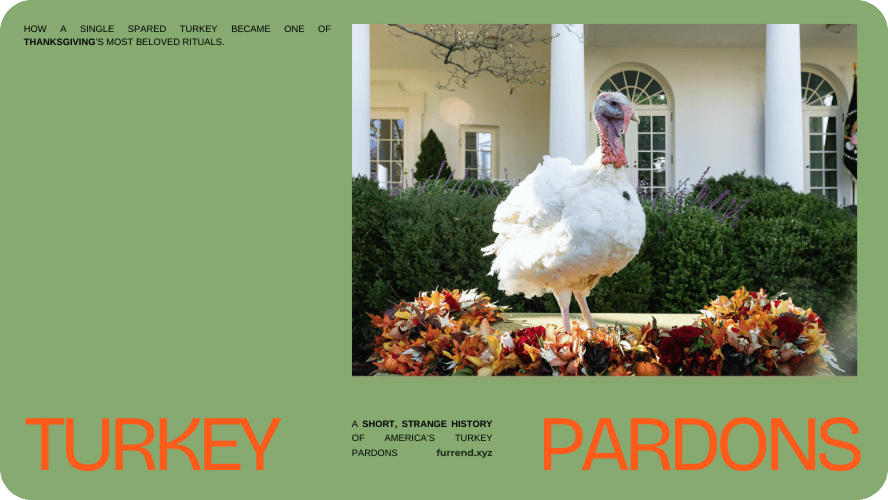
November 24, 2025
A Short, Strange History of America’s Turkey Pardons
From political jokes to presidential tradition, how a single spared turkey became one of Thanksgiving’s most beloved rituals.
Every November, in the middle of serious speeches and holiday travel chaos, the White House hosts a moment that feels part ceremony, part sketch comedy: a president stands beside a very confused turkey and grants it a “pardon.” For many people, it’s as ordinary a tradition as carving pumpkins or setting the table. But the turkey pardon isn’t ancient, or even especially dignified. It didn’t begin with Lincoln or Truman, and for decades the birds were dinner, not guests of honor. The real story is a mix of folklore, politics, public relations, and a surprising number of quirky birds who briefly became Thanksgiving celebrities.



The idea that the turkey pardon began in the 1800s is one of the most persistent holiday myths. A sweet story often credits Abraham Lincoln, whose young son Tad supposedly begged him to spare a turkey destined for the dinner table. It’s charming, but more folklore than fact.
Another common claim is that Harry Truman started the tradition. Also untrue. Despite the famous photo of him receiving a Thanksgiving turkey, Truman ate every bird he was presented.
The real history begins in the 1870s, when Thanksgiving turkeys first started arriving at the White House as gifts. For more than half a century, these birds were delivered, admired… and roasted. Nothing ceremonial about it.
In 1947, the National Turkey Federation (NTF) formalized the presentation of a live turkey. Still, there was no “pardon,” just a photo op and a polite handoff to the kitchen.
Then a small shift happened in 1963, when John F. Kennedy received an enormous 55-pound bird and said, “We’ll just let this one grow.” It was a symbolic act of mercy, but not yet the birth of a tradition.
The turning point came in 1987, during the Iran-Contra scandal. Reporters questioned Ronald Reagan about whether he planned to pardon two indicted aides. Reagan dodged the topic with a joke and said the only thing he was pardoning that day was the turkey.
Two years later, in 1989, George H.W. Bush made the modern tradition official. Patting a nervous tom turkey on the White House lawn, he declared: “Let me assure you, this fine turkey has a presidential pardon.” From that moment on, every administration has upheld the ritual.
So how does a turkey get chosen for stardom? The NTF raises a small flock of candidates, and the official bird (plus an alternate) is selected based on temperament. Their names come from public suggestions, and each pair is always perfectly themed: Liberty & Peace, Drumstick & Wishbone, Peanut Butter & Jelly, Corn & Cob, Chocolate & Chip, Peach & Blossom. Every year feels like the release of a limited-edition Thanksgiving Pokémon.
These birds do not always behave like diplomats. One escaped down the White House driveway. Another tried to take flight mid-ceremony. One reportedly bit a reporter. Many simply turned around and refused to face the cameras, proving that stage fright is not just a human thing.
After their big moment, most pardoned turkeys retire to petting zoos, university farms, or “gubernatorial estates,” where children visit them and local news checks in for annual updates. They become gently famous, mildly confused, and universally well fed, though they rarely live long due to the breed’s short natural lifespan.
Still, there’s something touching about the whole thing. A tradition that began as a political joke became an odd little ritual of mercy in a season devoted to gratitude. It’s a reminder that customs don’t have to be ancient to matter. Sometimes all it takes is a president, a crowd, and a turkey who has no idea why everyone is clapping.
Wherever you’re spending Thanksgiving week, we hope you’re warm, safe, and well fed. And if you see a turkey walking with a bit of extra swagger, it probably knows exactly what season it is.



More stories
Furrend circle
Be the first one to hear about updates